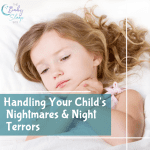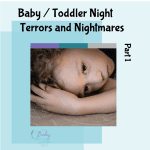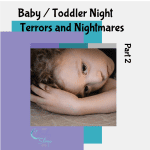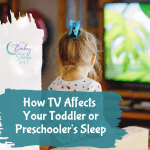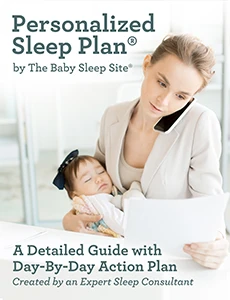
This week, we’re continuing our 2-part series about your toddler or preschooler’s nightmares and night terrors. Last week, we looked carefully at nightmares — when they begin, what causes them, and how we as parents can help our children through them.
This week, we’re taking a look at night terrors. While night terrors may not sound different from nightmares, in truth, night terrors are quite different and are far less common. They also tend to be far more terrifying and intense than nightmares, making them upsetting for parents.
In today’s article, we’ll explore what night terrors are, the ages at which they typically start and stop, and why children have them. We’ll also walk through some helpful tips to coping with a toddler’s or preschooler’s night terrors.
When and Why Do Night Terrors Happen?
It might seem odd to discuss the cause of night terrors before we actually look at what night terrors are, but stay with me here. 😉 It’s important to start with the ‘why’ behind night terrors because once we understand what’s happening to our little ones’ bodies and brains during particular sleep stages, we’ll better understand their night terrors.
If you read last week’s article, you’ll remember that nightmares happen during REM sleep — specifically, the longer REM cycles that happen in the second half of the night. Night terrors are closely linked to our sleep cycles, too. Nicole explains it this way, in a past article:
You might remember that beginning at around 4 months old, when we first fall asleep, it’s a transition into the deepest sleep of the whole night. This process takes approximately 30 minutes from bedtime for babies as they go into deep sleep faster than adults. The first sleep cycle lasts about 60 to 90 minutes and your baby (and you) will wake briefly as she transitions into the second sleep cycle, which is also deep sleep. The first few hours of sleep of the night is (supposed to be) the deepest. It is during this transition between sleep cycles that you wake briefly. You might roll over or you might pull the cover over you. It is usually brief and you go right back to sleep. This is NORMAL to wake briefly. Sometimes, however, this process is not so smooth and not so quick and explains why your baby sometimes wakes up crying.
Night terrors typically happen at the tail end of this first sleep cycle, as your toddler or preschooler is transitioning from her deep sleep to lighter sleep. Some kids seem to get “stuck” between sleep cycles; they’re not fully asleep, but they’re not awake, either. Nicole explains it this way:
What happens is part of your mind is trying to go back to sleep and part of your mind is trying to wake up and they are both trying to win.
This is the moment when night terrors occur.
What Are Night Terrors? (And How Are They Different From ‘Confusional Events’?)
We can’t discuss night terrors without discussing ‘confusional events’ as well. Why? Because they represent two sides of the same coin. True night terrors aren’t common; it’s estimated that just 1% of people ever experience them. Confusional events are far more common, especially for toddlers and preschoolers.
Like night terrors, confusional events usually happen in the first few hours after bedtime, as a child is transitioning from deep sleep to lighter sleep between sleep cycles. Confusional events may be mild: your toddler or preschooler may mumble or moan, toss and turn for a moment, and then go back to sleep. But they can also be fairly intense. As Nicole explains,
If the event is a bit more intense, your toddler might sleepwalk. She may walk up to you and seem to see right through you. Her eyes might be open, but she is still mostly asleep. Most kids won’t ever remember this happening. It could be a bit more pronounced such as a child jumping out of bed and moving around the room. She might seem upset or confused and may even say things like “No! Stop!” but not really appear too frightened. She might not recognize you and might push you away if you try to hug or touch her. It will likely be virtually impossible to either wake her or console her.
Confusional events like this can be short (a minute or so), but sometimes, they can last for 30 or even 40 minutes.
Night terrors are very, very intense confusional events. A person who’s in the midst of a night terror will look terrified, and may actually be violent. Night terrors don’t typically last very long; most night terrors are between 1 and 5 minutes long.
What Causes Confusional Events and Night Terrors?
It’s important to remember that mild confusional events are normal, and are simply a part of how we as humans sleep. Nicole puts it this way:
Partial wakings and confusional events are normal and happen from birth. The “confusion” comes in when your body’s drive to sleep is met with your body’s drive to wake. An example is when you are asleep and you hear the baby crying. You get up, walk to her room and start to feed her before you are fully awake. You might not even remember how you got into the room. Part of your mind was awake and part of it was asleep. If you are confused, you might go to the bathroom instead of the baby’s room and then wonder what you’re doing up when you hear the baby crying and finally, your brain starts to wake up. From birth, there will be times during sleep transitions that your baby’s drive to sleep is being challenged by the drive to wake up and your baby might cry or fuss between sleep cycles. This is why it’s important to not interrupt the process of going back to sleep if you can help it. We want the drive to sleep to win.
If your child’s confusional events are mild and irregular, then there’s nothing to worry about. If they’re intense, however, or if they’re happening frequently, then you’ll want to figure out what’s causing them and make a change (if possible.)
No one can say for sure what causes confusional events and night terrors in some children and not in others, but experts agree that the following factors definitely contribute:
- Overtiredness. This is a big one. Children who are overly tired or exhausted are more prone to confusional events and night terrors. If your child just went back to school, this could be the #1 factor.
- Disruption to sleep schedules and routines. If your toddler or preschooler’s bedtime and sleep schedules have been thrown out of whack for several days in a row, he’ll be more likely to experience a confusional event or night terror.
- Heredity. Interestingly, tendencies toward night terrors and confusional events (as well as sleepwalking and sleep talking) seem to be genetic. So if others in your family have experienced these, then it increases the odds that your toddler or preschooler will, too.
- Sleep disorders. Children who have other sleep disorders, like sleep apnea and Restless Leg Syndrome, are more likely to have confusional events and night terrors.
- Bladder awareness. This one doesn’t apply to night terrors, but it definitely applies to confusional events. I couldn’t find any hard evidence to confirm this, but there’s plenty of anecdotal evidence out there that seems to indicate a link between a toddler or preschooler having a full bladder and experiencing a confusional event. On his website, Dr. Alan Greene explains,
Recently, my youngest son was having a confusional arousal [event], and his mother observed that these events are most common at the same ages that children are becoming aware of the bladder feeling full during sleep. Perhaps some of these kids just need to go to the bathroom? We stood him in front of the toilet, and he urinated, still not awake. The episode faded abruptly, and he returned to sleep. The calm was dramatic.
Was this a coincidence? Or might this be a revolutionary new help for parents whose kids have these frightening episodes? A number of readers have tried this approach. Most said it worked wonders; a few said it had no effect.
How To Handle Confusional Events and Night Terrors
At best, it’s unsettling for parents to witness these episodes; at worst, it’s downright terrifying. And here’s the hardest part: parents, there is literally nothing you can do to make this stop once it’s started. Nothing. You just have to ride it out with your child.
However, these tips and insights might make the “riding it out” part a bit easier for both of you:
- Don’t touch your child. I know, I know — this runs counter to every parental instinct you have! But picking your child up, hugging her tight, trying to rock her, etc. will probably just make things worse. Many parents report that confusional events are shorter when they (the parents) don’t touch their children. Instead, try lying near your child. This is a way for you to provide some comfort without actually touching your little one.
- Don’t try to wake your child up, or make him “snap out of it”. Again, this is a totally normal instinct. But shouting at your child, or shaking him, in an effort to wake him up may just startle him even more, and make the episode worse. Instead, try turning on a dim light and talking or singing softly. This may gently, gradually rouse your little one and provide some comfort.
- Dress your child lightly for bed. This is more of a preventative tip. Some parents share that their children seem prone to episodes when they’re overheated. (The same is true for nightmares too.) So dress your child lightly for bed, and make sure she sleeps under light blankets.
- Try waking your child a few hours after bedtime. Again, this is another preventative tip. Around the time that your child would normally have a night terror, wake her from sleep. Make sure she’s fully awake; ask her to sit up, or to get up and walk around; offer her a small drink. Then, put her back to bed. Some parents report that this really does work — it serves to reset the child’s sleep clock, in a way, and prevents the night terror from happening at all.
- Make sure your child is getting the sleep he needs. A final preventative tip: take a good, long look at your toddler’s or preschooler’s sleeping habits and schedules, and be sure that your little one is getting enough sleep. Remember, overtiredness and chronic exhaustion contributes hugely, so ensuring that your little one is well-rested and has good nighttime routines in place can go a long way towards warding off nighttime issues.Need help in getting your toddler’s sleep on track? We’re here for you! Check out our e-book all about toddler sleep: The 5 Step System to Better Toddler Sleep. Don’t want to attempt this on your own? No worries! We can walk you through every step of the process!

